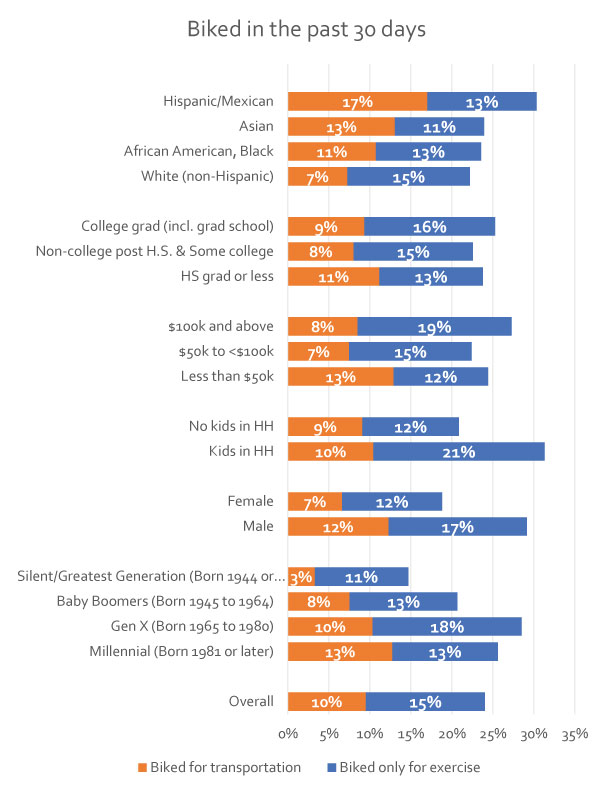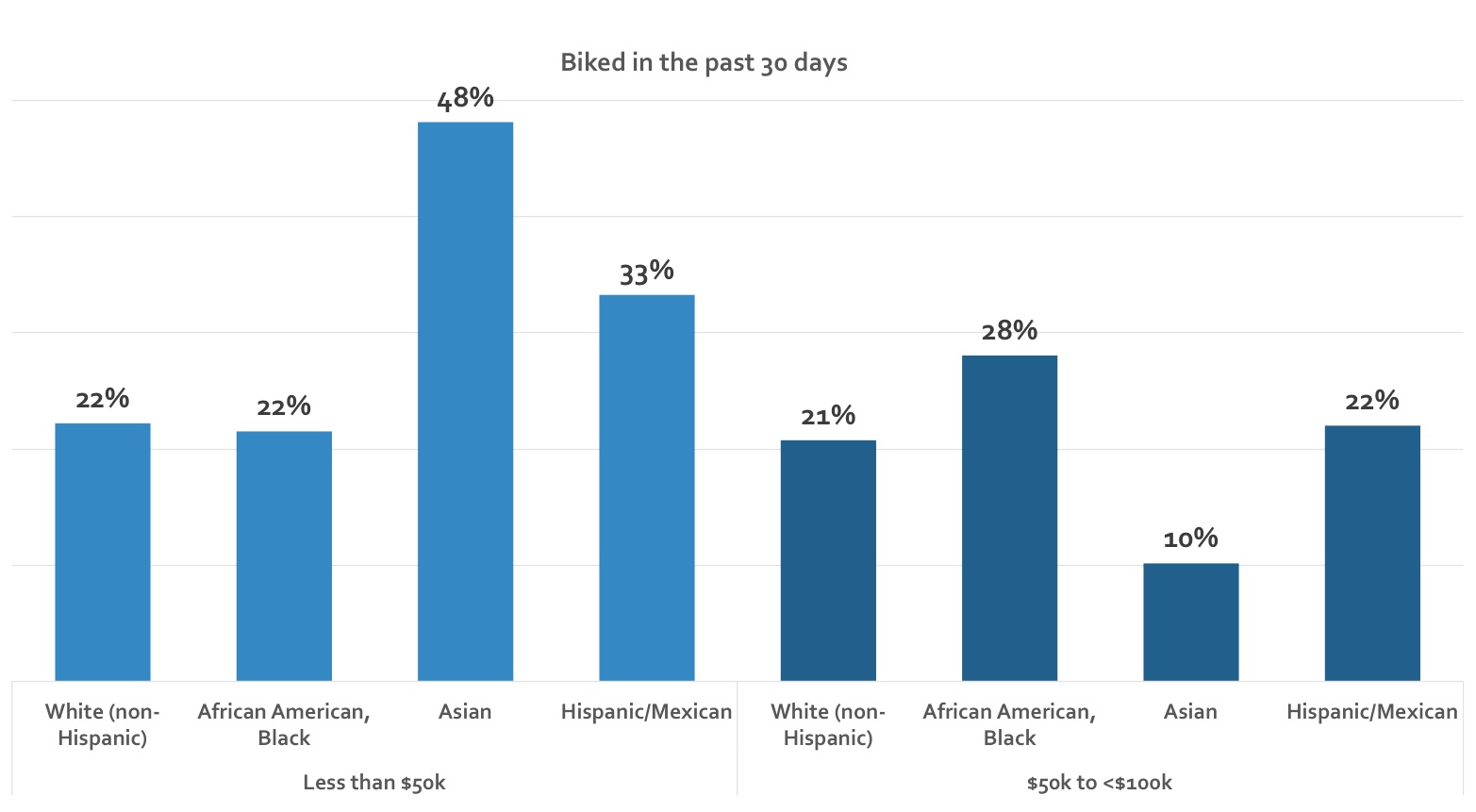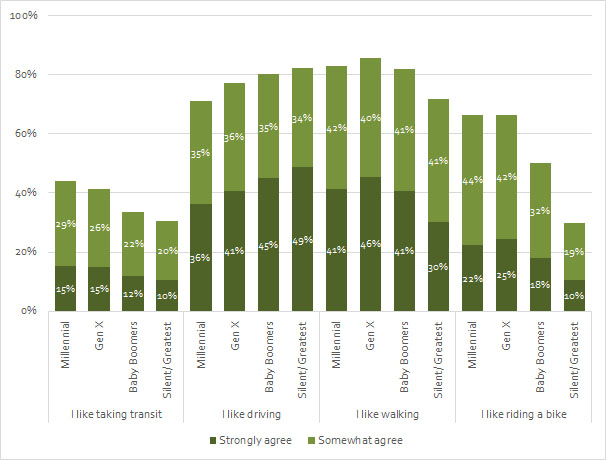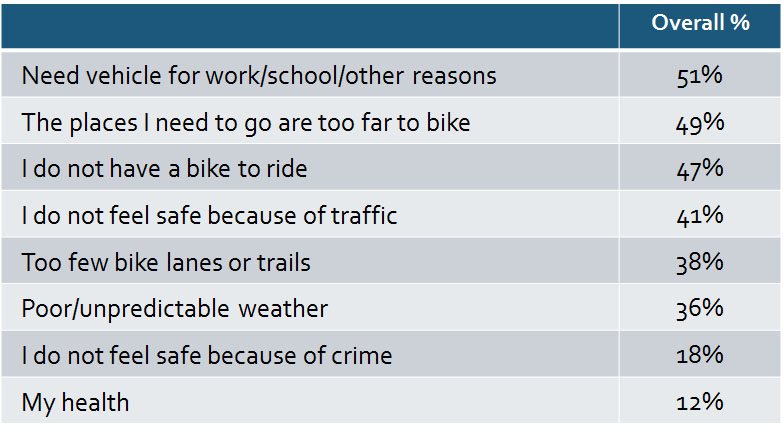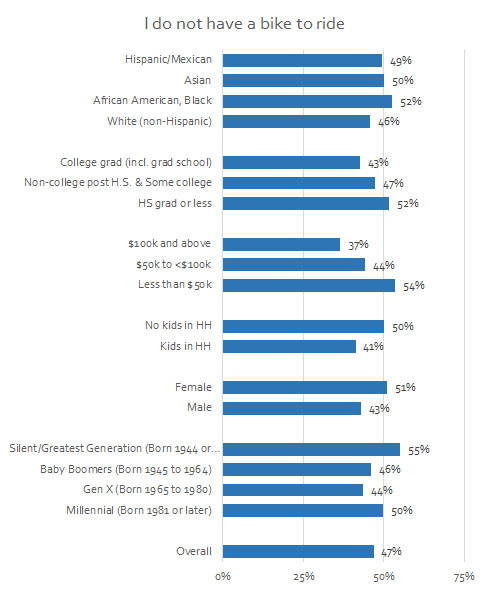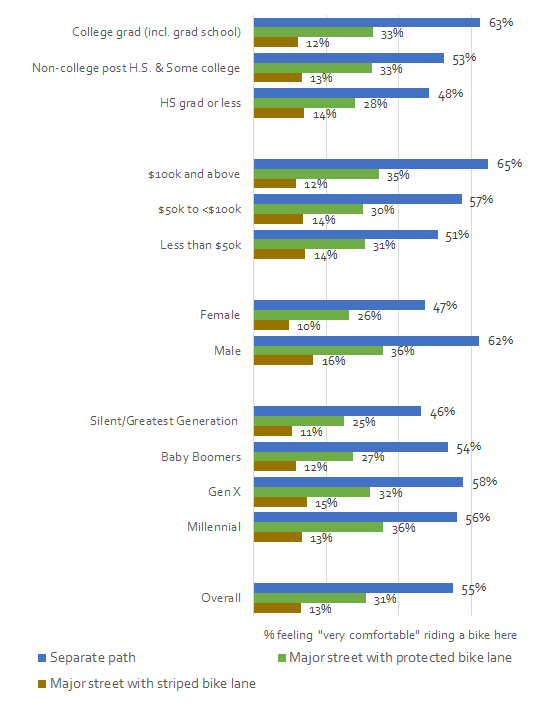posted by Anonymous on Tue, 07/28/2015 - 1:29pm
By Jennifer Dill, TREC director.
I recently completed a national poll of people living in urban areas in conjunction with the National Association of Realtors® on Community and Transportation Preferences. The overall results are posted here. The survey included 3,000 adults living in the 50 largest urban areas in the U.S. (That includes suburban areas, as well as denser urban cores.) Here are some highlights related to bicycling.
1. Less than one in five people have biked in the past month.
Overall, 72% of the adults surveyed said they were physically able and know how to ride a bike. Of those, 25% had ridden in the past month. (The survey was conducted in mid-May, so weather was reasonable.) That means only about 18% of adults in these urban areas biked recently. Most of the people who had biked, rode only for exercise (60%, or 15% of those who are able to bike), while the others (40%, or 10% of those who are able to bike) made at least some bike trips for transportation, such as to work, school, shopping, etc.
Note: From here on I will be focusing only on those people who are physically able and know how to ride a bike.
2. There are gender and generational gaps.
This isn’t a big surprise, but women were less likely to bike than men, 21% vs. 31% (Figure 1). And the gender gap is for both transportation and exercise riding. There’s also a generational gap. Only 14% of the Silent/Greatest Generation rode, compared to 21% of Baby Boomers, 28% of Gen Xers, and 26% of Millennials. You might have expected those millennials – known for not driving – to be biking the most. They do for transportation (13%), but the Gen Xers seem to be biking more for exercise.
Figure 1: Biked in the past 30 days (of those who are physically able and know how)
3. There are racial and income differences as well.
People in the highest income group biked the most overall, but those in the lowest income group biked the most for transportation. Overall, non-whites are biking more than whites, particularly for transportation. These two things are obviously related. Figure 2 shows the lowest (<$50k) and middle ($50-100k) income groups by race/ethnicity. In the lowest income group, Asians and Hispanics biked more. In the middle income group, whites stay the same, African-American rates go up, Asians and Hispanics down. There were too few non-whites in the highest income group to display them, but 28% of whites in that highest income group rode in the past month, and that bump was driven entirely by biking for exercise.
Figure 2: Biked in the past 30 days (of those who are physically able to and know how) by Race/Ethnicity and Income
4. People don’t like biking as much as walking.
Much of my research has shown that attitudes towards bicycling are an important factor in whether people bike for transportation. Overall, people were more likely to agree that they “like” walking and driving more than riding a bike. Millennials and GenXers are most agreeable, and the Silent/Greatest Generation really doesn’t like riding.
Figure 3: Attitudes towards different travel modes, by generation
5. What keeps people from biking more.
Our dispersed land use patterns are a key factor keeping people from biking more. About half of the respondents (who can ride a bike, but either do or don’t), said that the places they need to go are too far to bike. Large shares also don’t feel safe because of traffic and say there are too few bike lanes or trails.
6. Lots of people don’t have a bike to ride.
Almost half of the respondents said that not having a bike to ride was a reason they don’t bike. Obviously having a bike is linked to liking bicycling and wanting to ride, but this is a large share of the population with a pretty big barrier to riding. There were some differences between groups. Who’s less likely to have a bike? Women, people without kids, lower income adults, non-whites, and the oldest adults. Expanding bikesharing to more economically- and racially-diverse neighborhoods might help, and we’re starting a research project looking at that.
Figure 4: I do not have a bike to ride, by demographic groups
7. Protected bike lanes could help.
Those white stripes we’ve been installing on the side of major roads everywhere don’t seem to do it for most people. Only 13% of the adults said they would feel “very comfortable” riding a bike on a major street (4 lanes, 30-35 mph, on-street parking) with a striped bike lane. Contrast that with 31% who would feel very comfortable if that lane was “physically separated from traffic by a raised curb, planters, or parked cars.” Our study of such lanes in five cities shows some of the benefits of these lanes.
Figure 5: Percent feeling “very comfortable” riding in different biking environments
These are just a few highlights. I’ll continue exploring the data in more depth over the coming months. We have two webinars scheduled about the survey. On August 5 we’ll discuss the overall findings. On August 11, I’ll talk about the “four types of cyclists” using this new national data.

